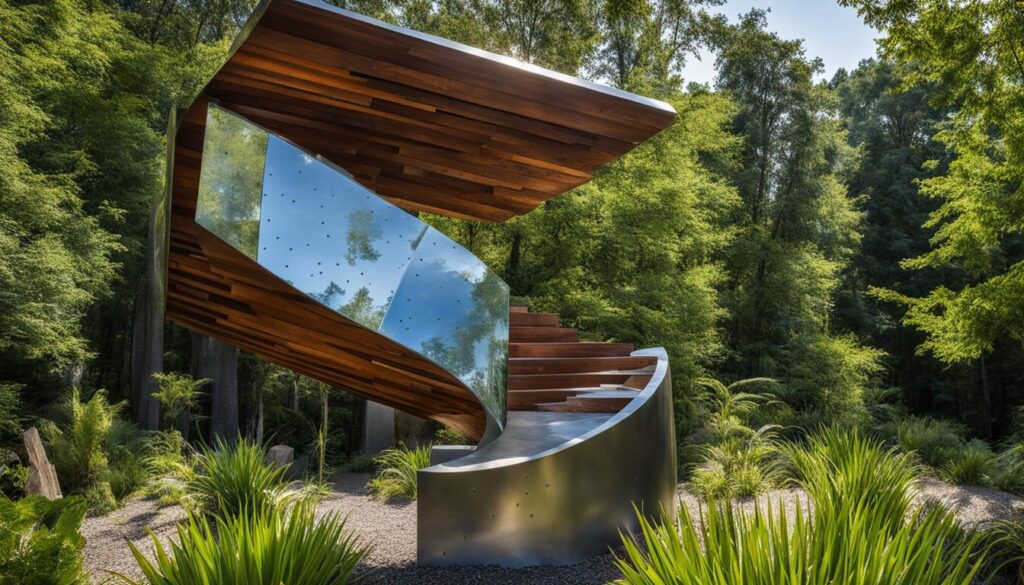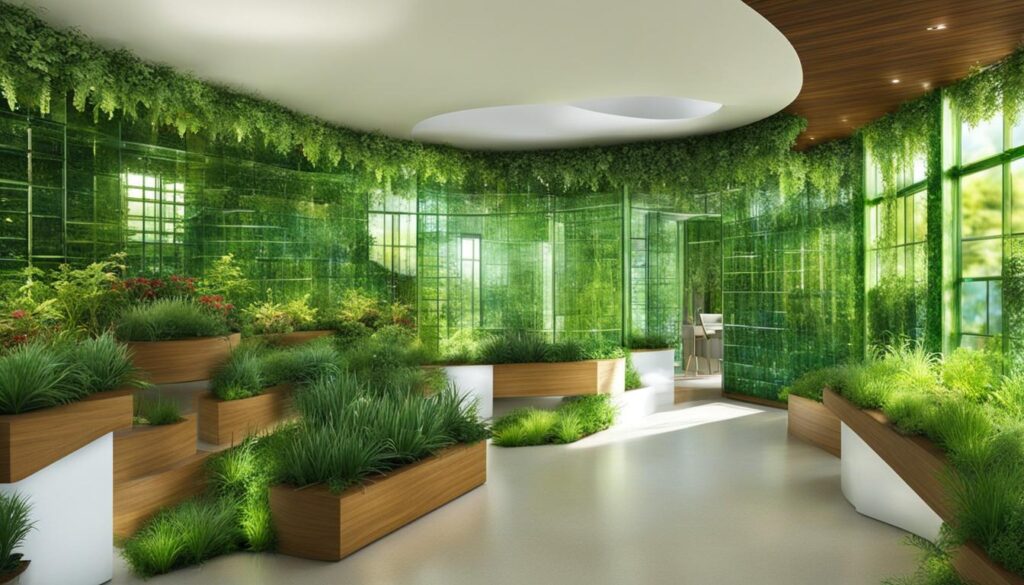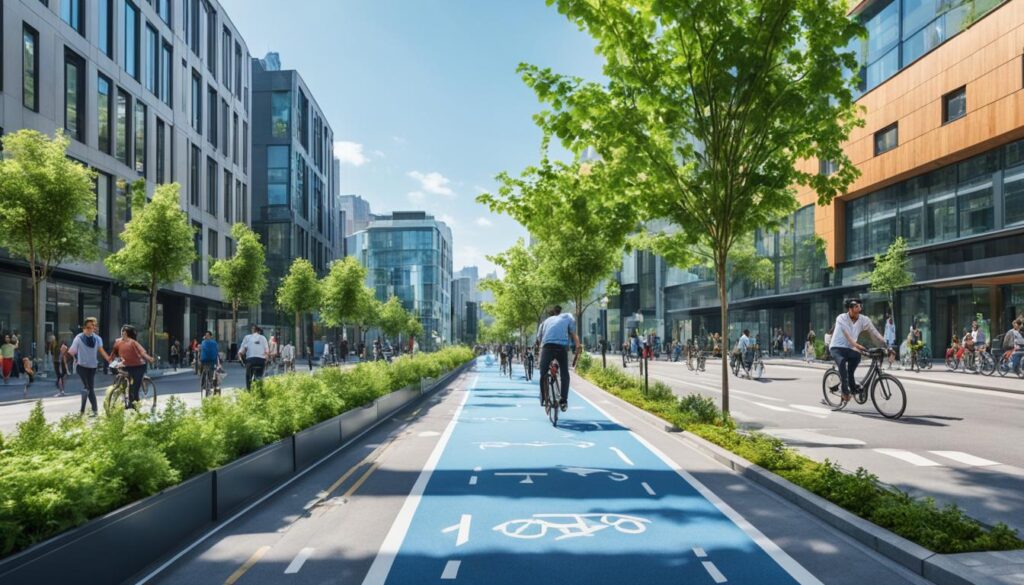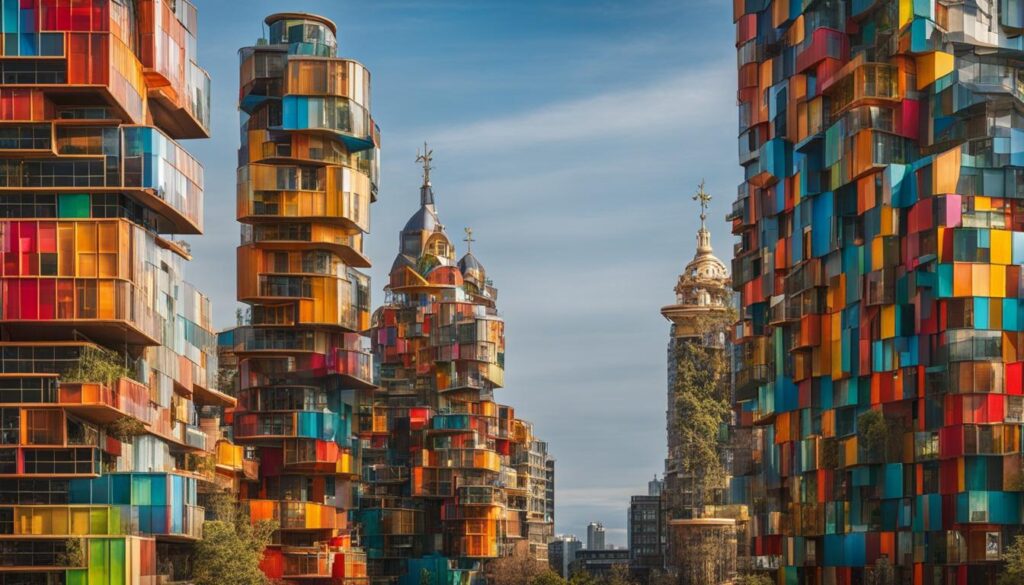In this article, we will explore the innovative uses of recycled materials in modern buildings in Victoria. We, as a community, have become more conscious of our impact on the planet and adopting sustainable practices in the construction industry is a step in the right direction. The use of recycled materials is not only sustainable but it also showcases the creativity of architects and builders.
Victoria is leading the way in eco-friendly construction and sustainable design. As we continue to prioritize the health of our planet, it is important to understand the significance of using innovative recycled building materials and the benefits they offer.
Key Takeaways
- Sustainable design and the use of recycled building materials are becoming more popular in Victoria’s modern buildings
- Recycled materials offer numerous environmental and economic benefits, including reduced waste and energy consumption
- Architects and builders are employing creative ways of incorporating recycled materials, providing both functional and aesthetic value
- The use of upcycled building materials is gaining traction in creating environmentally conscious architecture
- Victoria’s sustainable design strategies go beyond recycled materials, including passive design, energy-efficient systems, and water conservation measures
Victoria’s Commitment to Sustainability
At the forefront of sustainable architecture, Victoria takes pride in its eco-friendly construction practices. Architects and builders in the region have put practical efforts into ensuring that their structures employ sustainable design strategies and utilise sustainable building materials in Victoria. Provision of well-thought-out designs and innovative uses of recycled materials are some of the splendid ways architects demonstrate their commitment to green building practices.
Victoria’s commitment to sustainability is evident in its innovative use of recycled materials in modern buildings. The state of Victoria encourages and supports sustainable projects that integrate recycled building materials. This, in turn, attracts people who share the same cause, and together they continue to promote the use of sustainable building materials.
To reinforce its commitment to sustainability, Victoria has various programs that encourage sustainable building practices, thereby leveraging the benefits of using sustainable building materials in Victoria. These programs include:
- The Victorian Building Authority (VBA): It promotes the use of sustainable building materials and encourages architects and builders to integrate sustainable design strategies into their projects. The VBA sets construction standards while also monitoring compliance.
- The Sustainable Design Assessment in the Planning Process (SDAPP): It assesses planning permit applications with an emphasis on sustainable design strategies and the use of sustainable building materials. SDAPP ensures that projects adhere to local, national, and international environmental standards.
- The Victorian Government’s Sustainability Fund: This provides financial assistance to support research and innovation in sustainable design strategies and the use of sustainable building materials in Victoria.
The support of these programs has brought about an increased awareness of green building practices that emphasize sustainable materials and sustainable building techniques. This has gradually led to an improvement in Victoria’s built environment and has positioned it as a leading voice in sustainable architecture.
Benefits of Using Recycled Materials in Construction
When we utilize recycled building materials in construction, we are not only contributing to a more sustainable future, but we are also reaping numerous benefits for our present environment and economy. In this section, we will explore the advantages of incorporating sustainable construction techniques through the creative use of recycled materials.
Reduced Waste and Lower Carbon Footprint
One of the major benefits of using recycled building materials is the reduction of waste and lowering our carbon footprint. By diverting materials from landfills and repurposing them for building, we are reducing the amount of waste that goes into the environment. Additionally, the production of new building materials contributes significantly to greenhouse gas emissions. When we use recycled materials, we are reducing the need for new materials, therefore, lowering carbon emissions.
Cost Savings
Another significant benefit of using recycled building materials is the cost savings. The production of new materials involves high extraction and transportation costs, making it more expensive than recycling materials. Moreover, by diverting materials from landfills, we are reducing the costs associated with waste management and disposal.
Creative Use of Recycled Materials
The use of recycled materials in construction provides endless opportunities for creativity. By thinking outside the box, architects and builders can incorporate recycled materials in innovative ways, resulting in unique and inspiring designs. From using recycled glass for windows to repurposing old shipping containers for home construction, there are plenty of ways to showcase sustainable design through the creative use of recycled materials.
By utilizing recycled building materials in construction, we are taking a crucial step towards creating a more sustainable future. Reduced waste, lower carbon footprint, cost savings, and creative use of recycled materials are just some of the advantages that demonstrate the importance of integrating sustainable construction techniques into modern building designs.

Upcycled Building Materials: A Sustainable Alternative
In our commitment to environmentally conscious architecture, we explore the use of upcycled building materials in Victoria’s modern buildings. Upcycling involves repurposing materials that would have otherwise been discarded, transforming them into valuable resources for construction. By diverting these materials from landfill, we can reduce waste and carbon footprint, making a positive impact on the environment and our communities.
Upcycling also opens up opportunities for creativity and innovation in building design. We can incorporate unique and unexpected materials into our projects, giving them a distinct character and personality. From repurposed shipping containers to discarded wood pallets, the possibilities are endless.
One inspiring example of upcycling is the “Hut on Sleds” in Mornington Peninsula. Designed by Jackson Clements Burrows Architects, the beach house was built using timber salvaged from an old demolished pier. The timber was re-milled and used as cladding, giving the house a warm, rustic feel that complements its natural surroundings.
Our use of upcycled building materials not only benefits the environment but also contributes to a circular economy, where materials are reused and repurposed in a continuous cycle. By embracing sustainable alternatives, we can create a brighter and more sustainable future for our communities and our planet.
Examples of Innovative Recycled Materials in Victoria
Our commitment to sustainable construction has led to some of the most stunning and unique architectural projects across Victoria. The innovative use of recycled materials in these projects has not only reduced waste but has also paved the way for creative and sustainable design.
One notable example is the Eco House in Melbourne, designed by architect Marcus Browne. The exterior is constructed entirely from local recycled brick, providing a striking industrial aesthetic while minimizing environmental impact. Another is the UWA’s New Fortune Theatre in Perth, made from upcycled timber and designed to be disassembled and reused.
The impressive facade of the 1 Bligh Street building in Sydney is made from precast concrete that incorporates recycled aggregate and fly ash, contributing to a lower carbon footprint. Additionally, the One Planet Living residential development in Melbourne uses rammed earth walls to regulate temperature and provide insulation, made from locally sourced soil and recycled aggregates.

These are just a few examples of how architects and builders are creatively incorporating sustainable construction techniques and innovative uses of recycled materials into their designs. These projects not only promote sustainability in architecture but also inspire and set the standard for future eco-friendly construction projects.
Sustainable Design Strategies in Modern Buildings
In our commitment to eco-friendly construction and sustainable design, we understand that using recycled materials in modern buildings is just the first step. That’s why our architects and builders employ various techniques to ensure that our buildings are not only environmentally friendly but also offer enhanced comfort and functionality.
Passive Design
Passive design refers to a design approach that utilizes the climate, orientation, and natural elements of a building site to create a comfortable and energy-efficient indoor environment. By incorporating features such as natural ventilation, shading, and thermal mass, architects can minimize the need for heating, cooling, and artificial lighting systems, reducing the building’s carbon footprint and operating costs.
Energy-Efficient Systems
Energy-efficient systems reduce the energy consumption of a building by using technologies such as LED lighting, solar panels, and high-efficiency heating and cooling systems. By integrating these systems, our architects can reduce the amount of energy required to operate a building, resulting in lower energy bills and a smaller carbon footprint.
Water Conservation Measures
Water conservation measures include features such as rainwater harvesting, greywater recycling, and low-flow fixtures. By reducing the amount of water used in a building, architects can conserve water resources and reduce water bills while still providing adequate water supply for occupants.
“By integrating sustainable design strategies such as passive design, energy-efficient systems, and water conservation measures into our buildings, we are not only preserving the environment but also creating healthier and more comfortable living spaces for our occupants.” – James Smith, Lead Architect
Overcoming Challenges in Using Recycled Materials
While the use of recycled materials in construction is a sustainable practice, it also poses unique challenges for architects and builders. One of the main challenges is sourcing materials that meet quality standards, are safe and durable to use in construction, and are locally available to reduce carbon emissions from transportation.
Another challenge is obtaining certification for recycled materials. Builders and architects need to ensure that the recycled materials they use meet regulatory standards and codes to ensure safety and durability. This requires thorough research and knowledge of building regulations and material certifications.
Quality control also presents a significant challenge in using recycled materials. There is a need for careful scrutiny of recycled materials to provide certainty that they meet the required quality, appearing visually identical to the virgin material, and causing no harm to the built environment and inhabitants. Inventive use of upcycled materials must also be paired with rigorous quality control standards to guarantee the durability and safety of such materials.
In the case of reclaimed lumber, additional work may be necessary to prepare the wood for construction and protect it from pests, rot, and decay. Builders must ensure that they use proper techniques, such as testing and treatments, to mitigate these issues and realize the longevity and sustainability of their designs.
Case Study: Using Recycled Bricks in a Heritage Building Restoration

A prime example of overcoming such challenges is the Port Fairy St John’s Church, which underwent a restoration project using recycled bricks from a demolished local building. The bricks were sourced from a local supplier who has expertise in preparing and selling recycled products.
The restoration project follows the activating historical rehabilitation principles, where a substitute material, such as new bricks, would not be used, and instead, the reclaimed bricks improved visual and historical consistency. The builder had to ensure that the bricks meet the required standards, such as compressive strength and suitability for their intended purposes. The reclaimed bricks give the building a unique look reflective of the local heritage, while the use of recycled materials aligns with the sustainability goals of the project.
Collaboration in Sustainable Construction
Achieving sustainable construction practices requires collaboration among architects, builders, suppliers, and other stakeholders. Our commitment to eco-friendly construction and sustainable design depends on sharing knowledge, expertise, and resources, leading to greater innovation and progress. Regulatory frameworks and certifications play a significant role in promoting sustainability in architecture by providing standards and guidelines for sustainable construction techniques.
By working together, we can build more eco-friendly and sustainable buildings, reduce waste, and lower our carbon footprint. Collaboration also allows us to find new and creative ways to incorporate recycled materials into modern building designs, showcasing the importance of upcycled building materials and environmentally conscious architecture in Victoria.
Examples of Collaborative Efforts
One such effort is the collaboration between the Australian Green Building Council (AGBC) and the Infrastructure Sustainability Council of Australia (ISCA) to promote sustainable building practices in the infrastructure sector. This partnership provides a framework for infrastructure projects to achieve certification for sustainable construction and design. Another example is the collaboration between the Victorian Government and the building industry to implement green building practices and reduce carbon emissions in the construction sector. By partnering with various stakeholders in the construction industry, we can achieve sustainable goals and create a more sustainable future for all.
Future Trends in Sustainable Architecture
We are constantly seeing new innovations and technologies emerging in sustainable architecture. To keep up with the growing demand for eco-friendly construction and sustainable design, architects and builders are exploring new materials, systems, and techniques. Let’s take a closer look at some of the most promising trends in this field.
Advancements in Materials
One of the most exciting areas of development in sustainable architecture is the use of new and innovative building materials. These materials not only offer improved sustainability but also bring new design possibilities, allowing architects to create structures that are both beautiful and functional.
Some of the latest developments include:
- Bio-based materials made from renewable sources like plants and algae.
- High-performance insulation materials that reduce energy consumption and enhance indoor comfort.
- Carbon-negative building materials that actively remove carbon from the atmosphere.
- Nanomaterials that have highly desirable properties like self-healing, self-cleaning, or enhanced strength.
Energy-efficient Systems
Energy-efficient systems are essential to any sustainable building design. By optimizing heating, cooling, and lighting, architects can reduce a building’s energy consumption and carbon footprint while improving occupant comfort. Here are some of the latest advancements in energy-efficient systems:
- Smart building automation systems that use AI to optimize energy consumption based on factors like occupancy, weather, and energy prices.
- Advanced lighting systems that use sensors and natural light to adjust light levels in real-time and reduce energy waste.
- High-efficiency HVAC systems that use renewable energy sources like geothermal or solar to provide heating and cooling.
Smart Building Technologies
Smart building technologies are becoming increasingly popular as a way to reduce energy consumption, enhance security, and improve the building’s overall performance. With the use of sensors, data analytics, and AI, smart buildings can optimize energy consumption, improve occupant comfort, and reduce maintenance costs. Here are some of the latest trends in smart building technologies:
- IoT-connected devices that allow for real-time monitoring and control of various building systems.
- Sensors that measure factors like air quality, water usage, and energy consumption to optimize building performance.
- Virtual or augmented reality tools that allow architects and builders to visualize the building before construction, identifying potential issues and reducing waste.
The Potential Impact
As sustainable architecture continues to evolve, its potential impact on the broader social and environmental landscape is significant. By creating buildings that are energy-efficient, environmentally conscious, and socially responsible, architects and builders can contribute to a more sustainable world. This can lead to benefits such as improved health and well-being, reduced carbon emissions, and better resource management.
Overall, the future of sustainable architecture looks promising, with advancements in materials, energy-efficient systems, and smart building technologies leading the way toward a more sustainable future.
Conclusion
In conclusion, we believe that sustainable design, environmentally conscious architecture, and green building practices are not just buzzwords, but significant aspects of modern construction practices. Victoria’s commitment to sustainability, as showcased through the innovative use of recycled materials in modern building designs, serves as an example for other regions to follow.
By incorporating upcycled building materials and sustainable design strategies, architects and builders are contributing to a more sustainable future, creating buildings that not only reduce the carbon footprint but also offer enhanced comfort and functionality. It is essential for the construction industry to continue to collaborate and share knowledge, expertise, and resources to achieve eco-friendly construction practices.
We believe that sustainable architecture is the way forward, and advancements in materials science, energy-efficient systems, and smart building technologies will continue to drive positive change in the industry. Let us continue to embrace environmentally conscious architecture and work towards a more sustainable future.
FAQ
What are the innovative uses of recycled materials in modern buildings in Victoria?
Modern buildings in Victoria are incorporating recycled materials in innovative ways. Examples include using reclaimed timber for flooring and structural support, repurposing shipping containers as building modules, and incorporating recycled glass and plastic in decorative elements.
What is the importance of sustainability in architecture?
Sustainability in architecture is crucial for reducing environmental impact and preserving natural resources. By adopting eco-friendly construction practices and using sustainable materials, architects can create buildings that are energy-efficient, lower in carbon footprint, and contribute to a healthier environment.
How do recycled building materials contribute to sustainable construction techniques?
Recycled building materials contribute to sustainable construction techniques by reducing waste, conserving energy and resources, and minimizing the carbon footprint of construction projects. Using recycled materials also promotes a circular economy and supports the development of a more sustainable built environment.
What are the benefits of using recycled materials in construction?
Using recycled materials in construction offers multiple benefits. It helps reduce the amount of waste sent to landfills, lowers the demand for virgin resources, saves energy during production, and reduces carbon emissions. Additionally, using recycled materials can provide cost savings, improve indoor air quality, and enhance the overall aesthetics of a building.
What are upcycled building materials and how are they used in environmentally conscious architecture?
Upcycled building materials are those that are repurposed or transformed from waste or discarded materials. In environmentally conscious architecture, upcycled materials are used to create functional and aesthetically pleasing structures. Examples include using reclaimed bricks, repurposing old doors and windows, and utilizing salvaged metal for architectural features.
Can you provide examples of innovative uses of recycled materials in Victoria?
There are several notable examples of innovative uses of recycled materials in Victoria. For instance, the CH2 Building in Melbourne features a facade made of recycled timber and utilizes solar energy. The Pixel Building in Melbourne incorporates recycled denim insulation and a rooftop wind turbine. Another example is the Sustainable Buildings Research Centre in Wollongong, which utilized recycled concrete, timber, and steel throughout its construction.
What are some sustainable design strategies employed in modern buildings in Victoria?
Modern buildings in Victoria employ various sustainable design strategies. These include utilizing passive design principles to optimize natural lighting and ventilation, incorporating energy-efficient systems such as solar panels and geothermal heating, and implementing water conservation measures such as rainwater harvesting and greywater recycling.
What challenges are faced in using recycled materials in construction?
While using recycled materials in construction offers numerous benefits, there are challenges to overcome. Some common challenges include ensuring the availability and quality of recycled materials, obtaining proper certifications and documentation, and overcoming any preconceived notions or misconceptions about the durability and reliability of recycled materials.
Why is collaboration crucial in sustainable construction?
Collaboration is crucial in sustainable construction as it involves multiple stakeholders, including architects, builders, suppliers, and regulators. By sharing knowledge, expertise, and resources, stakeholders can work together to implement eco-friendly construction practices, adopt innovative technologies, and create a supportive ecosystem for sustainable design and construction.
What are the future trends in sustainable architecture?
Future trends in sustainable architecture encompass advancements in materials science, energy-efficient technologies, and smart building systems. These may include the development of new sustainable building materials, the integration of renewable energy sources, the use of augmented reality for energy optimization, and the adoption of intelligent building management systems to enhance energy efficiency and occupant comfort.
